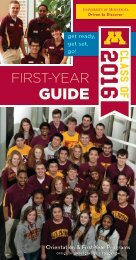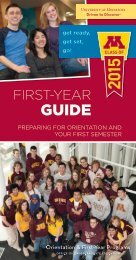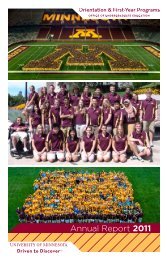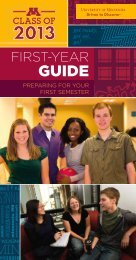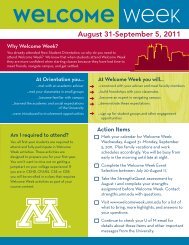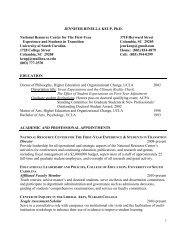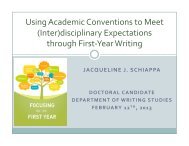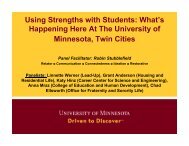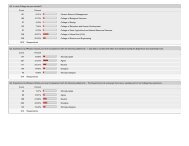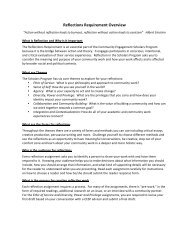The Principles of Strengths-Based Education - Orientation and First ...
The Principles of Strengths-Based Education - Orientation and First ...
The Principles of Strengths-Based Education - Orientation and First ...
You also want an ePaper? Increase the reach of your titles
YUMPU automatically turns print PDFs into web optimized ePapers that Google loves.
<strong>Strengths</strong>-<strong>Based</strong> <strong>Education</strong> 3<br />
attendance, achievement, credits earned, <strong>and</strong> retention. Although there are several measures that<br />
may be used to identify positive individual qualities, the most widely used assessment on<br />
campuses today is the Clifton <strong>Strengths</strong>Finder, an instrument developed by Gallup (1999) <strong>and</strong><br />
typically administered through <strong>Strengths</strong>Quest (Clifton, Anderson, & Schreiner, 2006), a resource<br />
that combines the assessment with additional information <strong>and</strong> learning activities designed for<br />
undergraduate populations. <strong>The</strong> Clifton <strong>Strengths</strong>Finder is an internet-based measure consisting<br />
<strong>of</strong> 178 paired comparison items <strong>and</strong> requires about 35 minutes for completion. Available in more<br />
than 20 languages, the instrument has been taken by over 500,000 students <strong>and</strong> 4 million people<br />
worldwide (Mark Pogue, personal communication, March 16, 2009). <strong>The</strong> Clifton <strong>Strengths</strong>Finder<br />
assesses 34 possible talent themes <strong>and</strong> provides respondents personal feedback on their five most<br />
dominant clusters <strong>of</strong> talent (referred to as signature themes), followed by descriptive statements<br />
about the themes <strong>and</strong> numerous recommended strategies or action items for capitalizing on each.<br />
<strong>The</strong> administration <strong>of</strong> the Clifton <strong>Strengths</strong>Finder is a common first step for most<br />
postsecondary institutions seeking to utilize a strengths-based educational model, <strong>and</strong> a rich<br />
diversity <strong>of</strong> curricula <strong>and</strong> programmatic efforts on today’s campuses support this instrument.To<br />
allow for a more rigorous examination <strong>of</strong> the effects <strong>of</strong> strengths-based approaches on<br />
engagement, achievement, well-being, retention, <strong>and</strong> job readiness, it may be useful to bring<br />
greater uniformity to strengths-based educational efforts in the future <strong>and</strong> to build such initiatives<br />
according to the five basic principles described subsequently.<br />
P<br />
<strong>The</strong> Five <strong>Principles</strong> <strong>of</strong> <strong>Strengths</strong>-<strong>Based</strong> <strong>Education</strong><br />
rinciple 1: Measurement <strong>of</strong> student (<strong>and</strong> educator) characteristics includes strengths<br />
assessment, which supplements the typical focus on academic achievement <strong>and</strong><br />
behavioral data (e.g., absences, living situation, <strong>of</strong>f-campus responsibilities, etc.).<br />
Educators rely on good data. Achievement tests (Carey, 2004; U.S. DOE, 2004) <strong>and</strong><br />
behavioral reports <strong>of</strong>ten shape perceptions <strong>of</strong> good students <strong>and</strong> effective schools more than any<br />
other type <strong>of</strong> assessment. Now, strengths <strong>and</strong> other positive personal variables (e.g., hope,<br />
engagement, <strong>and</strong> well-being) can be measured with confidence. By augmenting the existing data<br />
with data from measures <strong>of</strong> human strengths <strong>and</strong> other positive variables, educators can develop a<br />
more detailed <strong>and</strong> complex picture <strong>of</strong> academic success, its determinants, <strong>and</strong> its long-term<br />
benefits (Lopez, 2004).<br />
Educators measure what they value, <strong>and</strong> they work to enhance what they measure. Those<br />
within educational institutions have long valued achievement <strong>and</strong> its associated behaviors, yet<br />
boosting achievement, attendance, <strong>and</strong> retention has been a challenge. Potentially, student<br />
strengths <strong>and</strong> other indicators such as hope, engagement, <strong>and</strong> well-being might explain<br />
unaccounted variance in academic success. This hypothesis can only be examined when<br />
“positive” data are merged with existing data from large groups <strong>of</strong> American students.<br />
For students <strong>and</strong> educators, measurement <strong>of</strong> strengths also has some short-term benefits.<br />
Upon completion <strong>of</strong> the Clifton <strong>Strengths</strong>Finder, individuals receive five positive words for<br />
describing themselves. Students can carry these descriptors with them throughout their college<br />
career <strong>and</strong> into their first job <strong>and</strong> share them with their family <strong>and</strong> friends. Educators can do more<br />
<strong>of</strong> what they do best throughout their career by being mindful <strong>of</strong> their strengths.<br />
Principle 2: Educators personalize the learning experience by practicing individualization<br />
whereby they think about <strong>and</strong> act upon the strengths <strong>of</strong> each student.<br />
A strengths-based approach to working with students can be highly individualized,<br />
including efforts to personalize the learning experience (Gallup, 2003) by encouraging students to<br />
set goals based on their strengths <strong>and</strong> helping them to apply their strengths in novel ways<br />
______________________________________________________________________________



